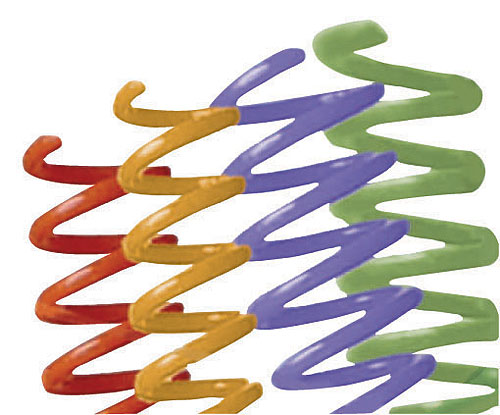
by: Anna C. Massey, Gateway Bookbinding Systems Ltd.
Plastic spiral binding is fast becoming the mechanical binding method of choice for many publishers, printers, and binderies. The product’s durability, the vast array of available colors to choose from, and advancements in the automation of the binding process have enabled spiral binding to inch (or coil!) its way onto millions of books each year. Plastic spiral has become a viable mechanical binding alternative to the traditional comb or single and double loop wire types of binding. Knowing what the options are and knowing what the experts recommend can help a company handle any production obstacles encountered when those challenging projects come through the door.
My bindery has tabletop electric punches and coil inserters for plastic spiral binding. The punch has a round hole in a 4:1 pitch. We do okay with books up to about an 18 or 20 mm coil diameter but anything thicker than that slows our output. What can we do to speed things up?
The rule of thumb for plastic spiral is simple. The larger the punch hole and wider the pitch spacing (distance between the holes), the easier the coil insertion process. The 4:1 pitch round hole that is common on most small or mid-range coil punching equipment is great for work that falls between about a 6 and a 16 mm coil diameter. However, if you are doing a lot of work thicker than about 5/8″ you really should consider incorporating a wider 3:1 (3 holes per inch) or 2.5:1 (2.5 holes per inch) pitch punch pattern for those thicker books.
It also is recommended that an oval shaped hole be used (versus a round hole). A hole that measures at least 6.5 x 5.5 mm in size works best. The oval (or “Double-D”) provides more height within the hole for the coil to find its “way down the books” binding edge. And the wider 3:1 or 2.5:1 pitch spacing means fewer holes for the coil to wind through. Oval holes – even in the 4:1 pitch – really speed things up. The larger oval hole, coupled with the wider pitch, will equate to improvements in production of up to 40 percent.
My supplier tells me that 4:1 pitch and 6 mm pitch and .2475″ pitch are all the same stuff, but coil equipment manufacturers tell me their equipment is “pitch specific.” If I punch 4:1 (4 holes per inch), is it important that I use 4:1 coil?
The term “pitch” refers to the distance between the punch holes or the actual loops of coil. For example, a 4:1 pitch means that there are exactly 4 holes within every 1 inch measurement. Should the same pitch of coil that matches the punch pattern be used? Absolutely! The 4:1 pitch is very common. There also are European machines that work with a metric 6 mm pitch. (That means that there are 6 mm from the center of one hole to the center of the next hole). The .2475″ pitch – although very close to the 4:1 / .250″ pitch – centers best on the common 11″ and 8.5″ binding edges without the need to pull any punch pins.
If punching a 4:1 pitch and running a 6 mm pitch coil through those holes, the smaller diameters of coil won’t run as well as they could. Larger diameters of coil are a little more flexible so they are a little more forgiving. There is, however, enough incompatibility between different pitches to affect productivity if the incorrect pitch is used.
When I am quoting a binding job for plastic spiral, I often find that the book production per hour rarely comes in at what I had estimated. Why is there such variation between jobs with the same size of coil?
When estimating a plastic spiral binding job, there are more than just the book’s thickness and binding edge length that need to be considered. The complexity of the book can dramatically affect its run through the bindery. Does the book have tabs? How many? Any inserts or folded pages? Oversized covers? What type of stock?
If a job comes through the door with tabs, the odds are that the tabs (and probably the covers) were punched separately from the body of the book. Unless the utmost care has been taken to ensure precise punch registration, when the components are married together there may be misalignment of the punch holes. Without good, clean punch registration, when the bindery operators go to insert the coil, the coil will get hung up as it tries to find its way through the holes. That slows down production per hour. Make sure the complexities of a project are understood in their entirety before estimating the production output.
There is equipment on the market that would let us manufacture our own coil. When does it make sense to bring this process in-house?
Studies show that when a bindery or in-plant is purchasing approximately $20,000 to $25,000 per year in coil, it is at the point that it makes financial sense to bring the coil manufacturing process in-house. In-house coil manufacturing usually represents a material savings of almost 50 percent. In addition, spools of filament are in stock, allowing the bindery to convert it to the various diameters and lengths required as needed. Inventory floor space is dramatically reduced, transport costs for spools of filament versus countless boxes of pre-formed coil also will be reduced, and the bindery is positioned to respond to its customers’ requirements much faster.

